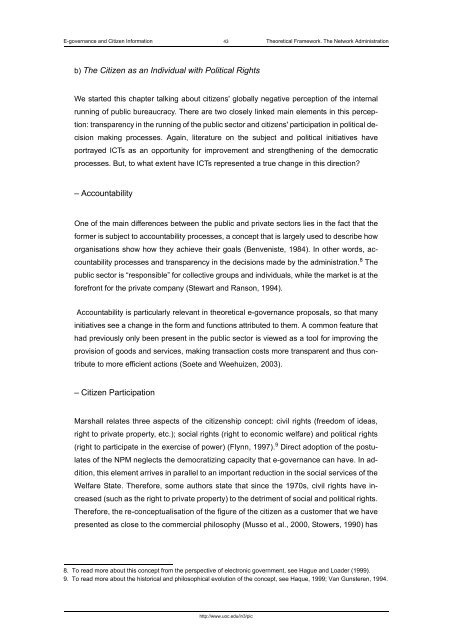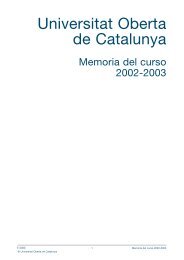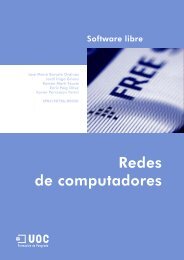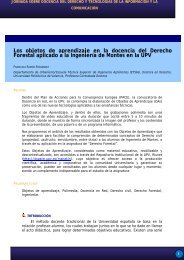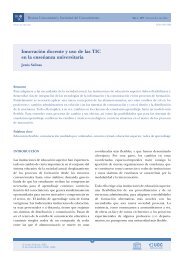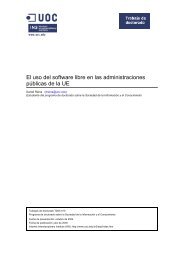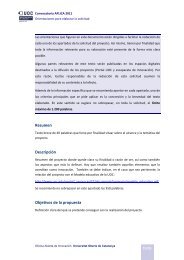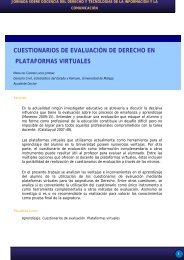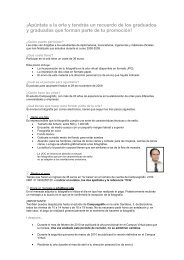e-governance and citizen information - Universitat Oberta de ...
e-governance and citizen information - Universitat Oberta de ...
e-governance and citizen information - Universitat Oberta de ...
Create successful ePaper yourself
Turn your PDF publications into a flip-book with our unique Google optimized e-Paper software.
E-<strong>governance</strong> <strong>and</strong> Citizen Information 43 Theoretical Framework. The Network Administrationb) The Citizen as an Individual with Political RightsWe started this chapter talking about <strong>citizen</strong>s' globally negative perception of the internalrunning of public bureaucracy. There are two closely linked main elements in this perception:transparency in the running of the public sector <strong>and</strong> <strong>citizen</strong>s' participation in political <strong>de</strong>cisionmaking processes. Again, literature on the subject <strong>and</strong> political initiatives haveportrayed ICTs as an opportunity for improvement <strong>and</strong> strengthening of the <strong>de</strong>mocraticprocesses. But, to what extent have ICTs represented a true change in this direction?– AccountabilityOne of the main differences between the public <strong>and</strong> private sectors lies in the fact that theformer is subject to accountability processes, a concept that is largely used to <strong>de</strong>scribe howorganisations show how they achieve their goals (Benveniste, 1984). In other words, accountabilityprocesses <strong>and</strong> transparency in the <strong>de</strong>cisions ma<strong>de</strong> by the administration. 8 Thepublic sector is “responsible” for collective groups <strong>and</strong> individuals, while the market is at theforefront for the private company (Stewart <strong>and</strong> Ranson, 1994).Accountability is particularly relevant in theoretical e-<strong>governance</strong> proposals, so that manyinitiatives see a change in the form <strong>and</strong> functions attributed to them. A common feature thathad previously only been present in the public sector is viewed as a tool for improving theprovision of goods <strong>and</strong> services, making transaction costs more transparent <strong>and</strong> thus contributeto more efficient actions (Soete <strong>and</strong> Weehuizen, 2003).– Citizen ParticipationMarshall relates three aspects of the <strong>citizen</strong>ship concept: civil rights (freedom of i<strong>de</strong>as,right to private property, etc.); social rights (right to economic welfare) <strong>and</strong> political rights(right to participate in the exercise of power) (Flynn, 1997). 9 Direct adoption of the postulatesof the NPM neglects the <strong>de</strong>mocratizing capacity that e-<strong>governance</strong> can have. In addition,this element arrives in parallel to an important reduction in the social services of theWelfare State. Therefore, some authors state that since the 1970s, civil rights have increased(such as the right to private property) to the <strong>de</strong>triment of social <strong>and</strong> political rights.Therefore, the re-conceptualisation of the figure of the <strong>citizen</strong> as a customer that we havepresented as close to the commercial philosophy (Musso et al., 2000, Stowers, 1990) has8. To read more about this concept from the perspective of electronic government, see Hague <strong>and</strong> Loa<strong>de</strong>r (1999).9. To read more about the historical <strong>and</strong> philosophical evolution of the concept, see Haque, 1999; Van Gunsteren, 1994.http://www.uoc.edu/in3/pic


